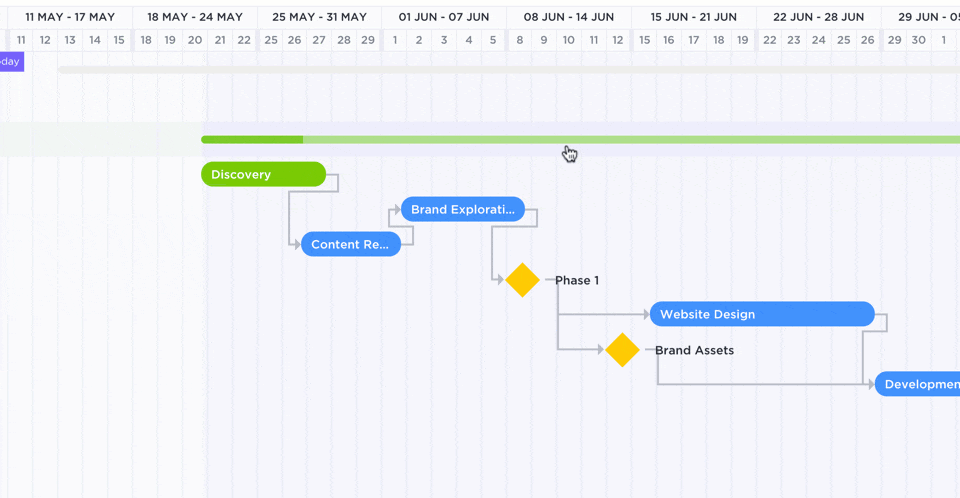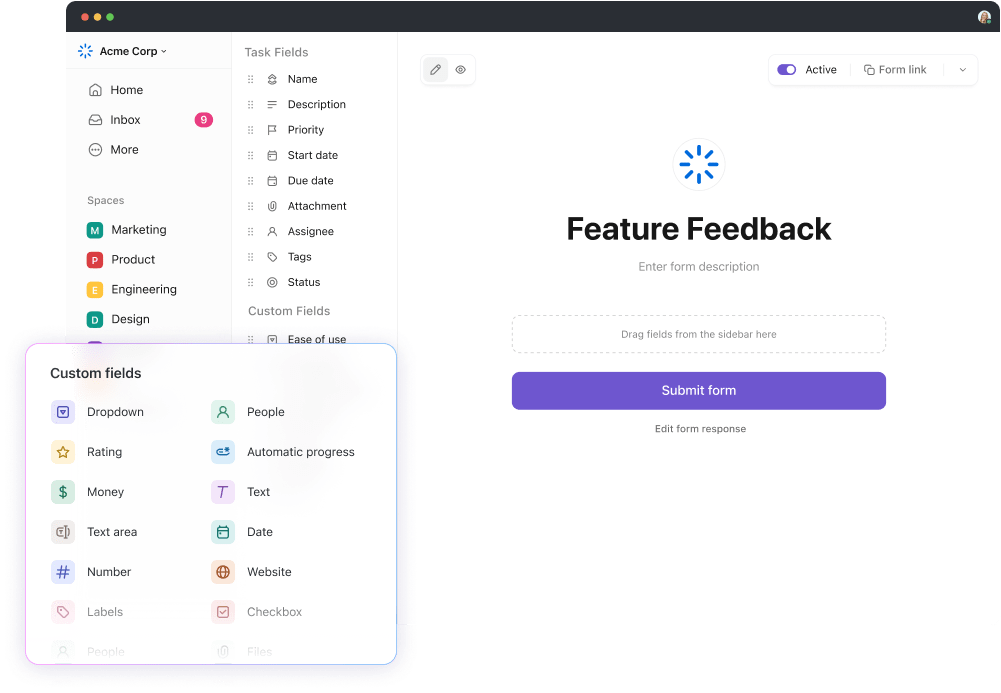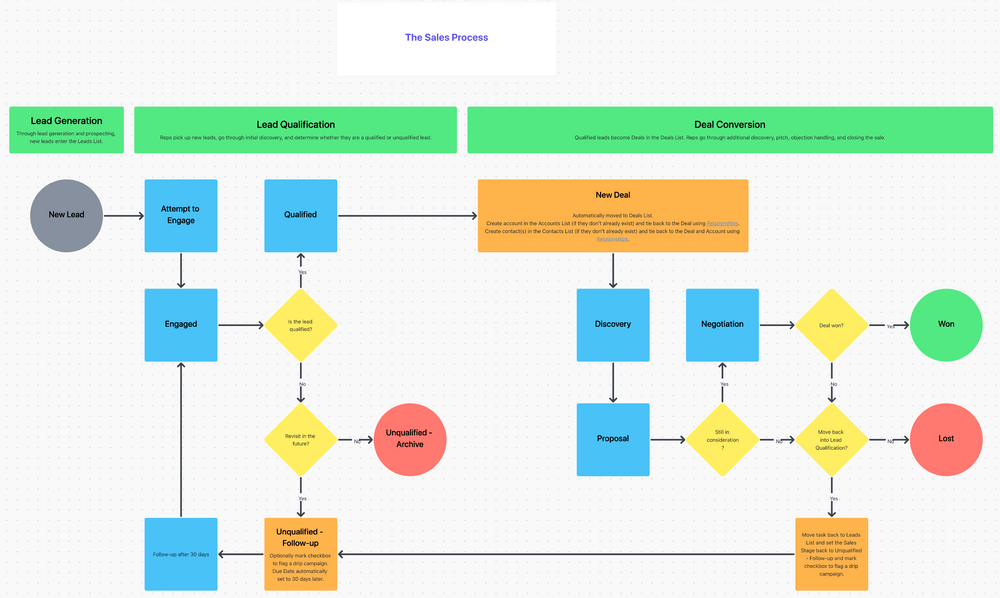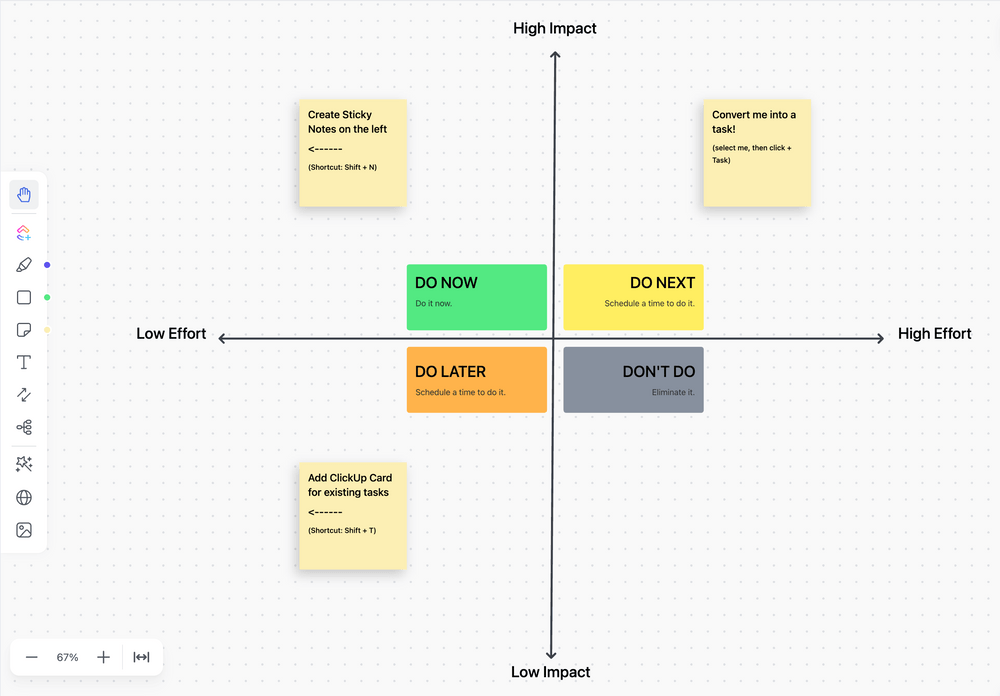

The idea of making consistent, regular, and incremental enhancements to work is everywhere. Toyota introduced Kaizen, Motorola created Six Sigma, and Agile engineering teams use continuous improvement.
The overarching theme is constant improvement to prevent stagnation in your business.
These improvements take many forms. They could be as simple as moving certain products to the impulse purchase counter at a supermarket or rearranging the entire assembly line to reduce waste.
Either way, there is always room for improvement. You can create significant process efficiencies by paying attention to your processes and optimizing them regularly.
Read on and learn how to use process optimization strategies and methods to streamline your business operations.
- What is Process Operations Optimization?
- Process Optimization Strategies & Frameworks
- How to Optimize Business Processes: Step-by-Step Guide
- Real-world Process Optimization Examples to Learn From
- Benefits and Challenges of Process Optimization
- How to Use Tools Like ClickUp for Process Optimization
- Simplify Business Process Optimization With ClickUp
What is Process Operations Optimization?
Operations optimization is the continuous activity of observing, understanding, improving, testing, and streamlining business processes to maximize desired business outcomes such as throughput, efficiency, productivity, profitability, or cost/waste reduction.
Teams can choose from different approaches to optimize processes depending on their specific requirements.
Types of Process Operations Optimization
Depending on the process, scale, impact, steps involved, and business goals, there are various process optimization methods. We’ve listed down some of the most common types of process optimization for you:
- Multi-objective optimization handles complex problems where trade-offs between multiple goals are required. Approaches include weighted optimization to prioritize specific goals based on their relative importance
- Mathematical optimization uses quantitative methods to maximize or minimize objectives (e.g., profits, costs) subject to constraints. For example, linear programming is used for optimizing resource allocation and deciding how much product to produce to maximize profit
- Business process optimization involves analyzing and refining workflows to improve how an organization operates, using frameworks such as Lean and Six Sigma
- Industrial process optimization aims to maximize efficiency and minimize costs in production and operations. For example, supply chain optimization focuses on logistics, warehousing, and distribution to reduce delivery times and costs
- Workflow optimization involves improving the use of resources and execution of tasks within an organization. This includes approaches such as bottleneck analysis to identify sources of delays and optimize them
- IT and software optimization focuses on improving the performance, reliability, and scalability of IT systems. It includes network optimization to reduce downtime and enhance connectivity in corporate or cloud-based systems, database optimization to accelerate data retrieval for users, and so on
- Environmental optimization balances sustainability with efficiency by minimizing a process’s ecological footprint. For example, sustainable design incorporates eco-friendly practices, like using recyclable materials in manufacturing
- Product optimization ensures products meet customer expectations while being cost-effective and competitive. Its approaches include user experience (UX) optimization to make digital products more user-friendly and cost optimization to reduce production costs without compromising quality
- Continuous process optimization sustains peak performance by making ongoing, incremental improvements over time. It involves approaches such as Kaizen, the Japanese philosophy encouraging small, daily improvements in processes, and the use of Agile methodologies in software development
- Machine learning-based optimization uses data and algorithms to dynamically enhance processes. It includes techniques such as predictive analytics to optimize decisions, and reinforcement learning to automate decision-making processes for faster operations
Process Optimization Strategies & Frameworks
Here is an overview of the most common process optimization techniques and frameworks used across different industries and organizations.
a. Lean management
Lean focuses on eliminating waste (anything not adding value) and creating more value for customers. Its key principles include value stream mapping, just-in-time (JIT) production, and continuous improvement (Kaizen).
Common applications:
- Manufacturing: Reducing waste in production lines (e.g., Toyota Production System)
- Healthcare: Streamlining patient flow and reducing waiting times
- Retail: Managing inventory to avoid overstocking or stockouts
b. Six Sigma
This data-driven process improvement methodology minimizes defects and process variability to achieve near-perfect quality (3.4 defects per million opportunities). It focuses on the DMAIC framework (Define, Measure, Analyze, Improve, Control).
Common applications:
- Manufacturing: Improving product quality and reducing defects
- Finance: Reducing errors in financial transactions
- Service Industry: Enhancing customer satisfaction by standardizing services
c. Process mining
This business process optimization technique analyzes event logs from IT systems to identify inefficiencies and bottlenecks.
Common applications:
- IT Systems: Detecting process deviations in ERP or CRM systems
- Banking: Analyzing loan approval workflows for inefficiencies
- Healthcare: Tracking patient journey to optimize care delivery
d. Process modeling and simulation
This process improvement technique visualizes processes using flowcharts or software tools and simulates different scenarios for operations optimization.
Common applications:
- Supply Chain: Optimizing logistics and warehouse management
- Business Operations: Simulating various staffing or scheduling scenarios
- Engineering: Designing efficient manufacturing processes
e. Business process reengineering (BPR)
The optimization technique involves a radical redesign of business processes to achieve dramatic improvements in performance.
Common applications:
- E-commerce: Automating manual order fulfillment processes
- Banking: Overhauling customer onboarding processes for speed and simplicity
- Manufacturing: Redesigning production lines to reduce lead times
f. Total quality management (TQM)
TQM is a holistic approach to long-term success through customer satisfaction and continuous improvement across all organizational levels.
Common applications:
- Automotive: Enhancing product reliability and customer satisfaction
- Hospitality: Improving guest experience through staff training and service standardization
- Education: Streamlining administrative processes for better student outcomes
g. Theory of Constraints (TOC)
TOC, or the Theory of Constraints, was developed by Dr. Eliyahu Goldratt, an Israeli physicist turned management guru. It focuses on identifying and addressing the most significant limiting factor (bottleneck) in a process.
Common applications:
- Manufacturing: Optimizing production line throughput
- Project Management: Managing critical path tasks in large projects
- Supply Chain: Resolving distribution bottlenecks
h. Agile methodologies
Agile is a flexible and iterative approach to optimizing processes, primarily used in software development.
Common applications:
- Software Development: Delivering updates and features incrementally
- Marketing: Running iterative campaigns with real-time feedback
- Product Design: Rapid prototyping and testing with customer input
i.Root cause analysis (RCA)
Root cause analysis is a problem-solving method to identify the underlying causes of process inefficiencies or failures.
Common applications:
- Healthcare: Investigating causes of patient care errors
- Manufacturing: Analyzing frequent machine breakdowns
- IT: Addressing recurring system outages
Also Read: Root Cause Analysis Templates
j. Value stream mapping (VSM)
Value stream mapping is a Lean tool for visualizing processes to identify non-value-adding steps and optimize workflows.
Common applications:
- Manufacturing: Mapping production processes to eliminate waste
- Healthcare: Visualizing patient care processes to improve throughput
- Logistics: Analyzing order fulfillment to reduce delays
How to Optimize Business Processes: Step-by-Step Guide
Step 1. Identify and prioritize the processes to be optimized
Every process has the potential to be optimized. A good business analyst will know what to optimize and when. As a best practice, begin by asking the following questions to the project teams.
- What business processes take too long?
- What processes fail too often?
- Where does wastage occur?
- Which teams wait for information/approvals etc.?
- Which processes don’t produce outcomes that meet the standards set within the organization?
These questions should give you a list of processes that need to be optimized. Once you have this, begin prioritizing. While doing so, consider three factors: effort involved, disruption expected, and potential outcomes.
If you’re just beginning to optimize business processes in the organization, you might want to prioritize those that need moderate effort, cause minimal disruption, and deliver medium to high outcomes.
💡Pro Tip: ClickUp’s Impact Effort Matrix Template is designed to help you quickly and accurately evaluate the impact and cost so that you know which processes to prioritize.
If you have a mature workflow optimization program, you might choose business processes that require high effort and cause high disruption while delivering high outcomes. The risk of disruption might be worth considering the results it will deliver.
Step 2. Analyze and map the current process
While performing the previous step, you might have understood the basics of what the process entails. Now, it’s time to analyze it more thoroughly.
List every step of the process in as much detail as possible. Speak to the project teams. If they collaborate with other departments, speak to them, too.
💡Pro Tip: Visualize how tasks flow into each stage of the project and categorize them into goals, activities, and action items with ClickUp’s Process Map Template.
Note down every inadequacy/inefficiency in each step. For example, in an accounts payable process, uploading invoices to the ERP system might be taking too long, making it ripe for automation. In the marketing department, some designs might be off-brand, requiring better quality control measures.
Ask why the process is the way it is. Often, operations teams change existing processes without clearly understanding the current process.
This can have disastrous effects on other parts of the process or other connected processes.
Once you’ve documented this analysis, map the processes visually. Include related processes to understand the entire landscape.
💡Pro Tip: Use a Gantt Chart to spread it over some time. This helps us see these processes clearly and lays them over various scenarios.

Step 3. Brainstorm improvements to business processes
Think of various improvements you can make to the inefficient business processes. Ask the project team for suggestions—often, they know best what they need.
Take inspiration from other departments that might have already solved this problem. Explore all possible solutions.
A sound mind map is a great way to document all these ideas without fearing a blank page or constraints of rows and columns.

💡Pro Tip: Brainstorming tools like ClickUp Whiteboards help you collaboratively ideate with team members and turn ideas into action at a single click.
Step 4. Prioritize improvements
Once you have a list of possible process optimizations, discuss each in detail. Identify the most likely to solve the problem and deliver the desired outcome while staying within the operational and budget constraints.
For example, if the problem is delays caused by the manual uploading of paper invoices to the ERP, the potential process improvement might be:
- Implementing an AI-powered scanning program that automatically extracts data and updates the ERP. This is high cost, high effort with debatable ROI
- Adding more staff to do the data entry is expensive and unscalable
- Requesting all vendors to send digital invoices via email. This is low cost, high effort, and has a long change cycle
Based on your priorities and constraints, choose the solution that’s right for you.
💡Pro Tip: Use Task Priorities in ClickUp to clearly plan next steps
Step 5. Test the process improvements
Before you implement the process improvements, test them on a smaller scale. You might do this by applying the changes to a small set of users or for a short period.
Monitor the user responses to the improvements and measure the outcomes. Collect qualitative and quantitative feedback from all stakeholders to ensure your intentions are met.
💡Pro Tip: Custom Fields in ClickUp help you compile data as granularly as you wish.

Step 6. Implement and improve
If your test succeeds, implement it for the entire organization while preparing for change management.
- Educate all stakeholders about the changes you’ve made
- Invite them to ask questions and respond proactively
- Set up a system to address any issues they might face because of the process optimization you’ve implemented
- Design the metrics and mechanisms to measure outcomes at scale
Most importantly, monitor how each user is adopting the new process. Identify potential opportunities to optimize it further. Keep your inbox open to feedback.
💡Pro Tip: Make this step easier with change management templates.
Real-world Process Optimization Examples to Learn From
1. Toyota: Lean manufacturing (Toyota Production System)
Problem: Inefficiencies and waste in the production process
Solution: Toyota developed the Lean Manufacturing approach, emphasizing:
- Just-in-Time (JIT) or producing only what is needed, when it is needed, in the quantity needed, to reduce inventory costs
- Kaizen or continuous small improvements in processes involving all employees
Results:
- Increased production efficiency
- Reduced waste and inventory costs
- High-quality vehicles with minimal defects
2. General Electric: Six Sigma for quality control
Problem: High defect rates and process variability in manufacturing and service operations
Solution: GE adopted the Six Sigma framework to reduce process errors and improve efficiency
- Trained employees as Six Sigma Green Belts, Black Belts, and Master Black Belts
- Used the DMAIC methodology to analyze processes, identify inefficiencies, and implement solutions
Results:
- Savings of over $12 billion through improved efficiency
- Enhanced customer satisfaction due to consistent product quality
3. Starbucks: Workflow optimization in retail operations
Problem: Long waiting times during peak hours in stores
Solution: Starbucks optimized workflows in stores to improve speed and efficiency.
- Implemented value stream mapping to identify bottlenecks in the drink preparation process
- Redesigned store layouts to reduce barista movement and streamline operations
- Introduced mobile ordering to reduce in-store congestion
Results:
- Faster service times during peak hours
- Increased sales from mobile orders
- Improved customer satisfaction
Benefits and Challenges of Process Optimization
Process optimization can be a complex endeavor. It involves making small yet significant changes to processes people follow daily, often subconsciously. Every process optimization has some level of disruption.
The only difference between the successful ones and others is that the former’s results outweigh the disruption’s effects. Good process optimization can benefit you in any of the following ways.
Benefits of process optimization

- Minimizing inefficiencies: Most often, the most significant benefit of optimizing processes is that it eliminates inefficiencies. It reduces time, manual effort, loss of throughput, etc., to enable teams to do more with less
- Cost savings: Optimized processes minimize wastage and prevent productivity losses, which saves the organization costs. For example, if a developer is waiting six hours for a cloud environment to be provisioned, reducing that can improve productivity and reduce compensation
- Better resource allocation: Process optimization ensures resources like employees, equipment, and inventory are used effectively. High-priority activities are streamlined, avoiding overburdening specific areas and ensuring every resource contributes to achieving organizational goals
- Improving quality: A robust process is the foundation of good quality output. Process optimization ensures all quality procedures are adhered to, improving the final product
- Fostering collaboration: While a process is typically a series of steps, many involve multiple people or teams working together. An optimized process needs seamless knowledge-sharing and hand-offs between them. Continuous process optimization enables this, fostering stronger collaboration
- Faster decision-making: Tools like process mining and predictive analytics provide organizations with real-time data and actionable insights. This allows for quicker identification of bottlenecks or areas for improvement, accelerating informed decision-making
- Enhanced customer satisfaction: Optimization shortens delivery times, improves service reliability, and results in higher-quality products or services. These factors directly improve customer experiences, leading to higher satisfaction and loyalty
- Mitigating risks: The often ignored benefit of process optimization is its ability to reduce risks significantly. In financial services, a well-optimized process can prevent fraud. In healthcare, it can save lives. In software, it can minimize security breaches and strengthen privacy, confidentiality, security, and compliance postures
- Scalability and growth: When processes are optimized, it becomes easier to scale operations as business demand grows. Well-designed systems and workflows provide the structural stability needed to support long-term growth and scalability
- Competitive advantage: Through optimization, organizations can improve their market responsiveness, operational agility, and cost efficiency. These improvements allow companies to offer competitive pricing and stay ahead of rivals while maintaining quality standards
An operational intervention that can deliver such exceptional benefits does not come without challenges. Let’s explore what you will likely encounter in your process optimization journey and how to overcome them.
Challenges of process optimization
- Limited view of the process: Often, people jump to make changes to processes they deem inefficient. So, they make changes without understanding their impact on the people, process, and connected workflows. Imagine moving the cafeteria to the terrace to save on lighting without realizing it doesn’t have wheelchair access. Such changes can have counterproductive consequences
- High initial investment: Implementing optimization frameworks often requires significant upfront investment, including costs for technology, employee training, and consultancy services. Smaller organizations, in particular, may find it challenging to allocate sufficient resources to such initiatives
- Process complexity: Not all processes are simple and sequential. Therefore, changing one step might make the rest of the complex processes collapse like a stack of cards
- Resistance to change: People often resist change, even if they don’t outright reject it. They might subconsciously continue to follow the old process, causing inefficiencies for themselves and others
- Insufficient ROI: Most process optimization programs look for a return on investment through increased sales, productivity, speed, etc. The business processes that can’t make such returns apparent might get ignored, losing out on significant opportunities
- Security and privacy concerns: Advanced tools like AI and process mining may expose sensitive business or customer data to cybersecurity risks. Organizations also face the challenge of complying with stringent data protection regulations, such as GDPR, which can complicate the implementation of optimization initiatives
- Data dependency: Optimization relies heavily on accurate and complete data. Poor data quality or inadequate data collection methods can undermine the results of an optimization project, leading to inefficiencies or inaccurate insights
- Time-consuming process: Process optimization projects often take a long time to deliver measurable results. Continuous monitoring and refinement are needed, which can stretch resources and test an organization’s patience for long-term gains
- Lack of leadership buy-in: Small, incremental changes are often outside the radar of business leadership. This makes such process optimizations more challenging to implement and enforce
As you can see, these challenges are not in process optimization itself but in the implementation of it. With the right process improvement tools, you can overcome these challenges and streamline operations. Here’s how.
How to Use Tools Like ClickUp for Process Optimization
We live in a world of tool overload. There are dozens of tools for project management, collaboration, communication, and so on. Leverage the right tool stack to improve the outcomes of your process optimization efforts.
Collect accurate and relevant data
Data collection is not a one-time activity. Therefore, you need a systematic approach from multiple perspectives to make your data collection effective.
Run surveys to understand the team’s concerns with the process you’re looking to optimize. ClickUp’s conditional formatting Form view helps you create smarter forms to collect ideas and feedback.

Use a time tracker to measure how long each step in the process takes. The ClickUp time tracker is an excellent tool to do this. You can start/stop the timer or manually add the time spent. You can do this anywhere—mobile, browser, or native apps.
Look at completed project archives to learn more about how the tasks are performed. Go through comments and checklists to analyze current processes. Or just ask the AI Project Manager in ClickUp Brain to find this information for you.
Collaborate effectively
No process can be successfully optimized without collaboration, whether when collecting data, brainstorming ideas, implementing the change, or measuring results. Modern collaboration tools make this possible.

Use ClickUp Notepad to take notes and share them with the team. What’s more? Use the AI tools to proofread and summarize them as well.
Use tools like the ClickUp Whiteboards to visualize business processes. Drag and drop steps, add dependencies, and make it visible for everyone to comment. This creates comprehensive visibility, bringing everyone on the same board!
You can also use ClickUp Mind Maps to simulate potential improvements and let teams annotate too.
Debate ideas. Propose changes on a shared document with ClickUp Docs, inviting team members to review and offer feedback. Use the comments feature to debate any improvements you suggest, exploring the pros and cons asynchronously.

Or, get the whole team on a single chat thread to exchange ideas. With ClickUp Chat, you can do this through async chat threads or audio or video calls.
Plan and present better processes
Better planning, presentation, and communication can address challenges related to resistance to change and leadership buy-in. We’ve also got tools for that!
Use the ClickUp Gantt Chart View to visualize the process over time. Create before and after views to show the difference process optimization makes. This will help teams imagine the potential upside to accepting the change.

Streamline connected processes with ClickUp Dependencies. Link-related tasks, customers, orders, deals, users, bug reports, documents, etc. View all relationships and dependencies in one place to make the right decisions.
Use ClickUp Automations to do the busy work. Automatically change assignees and priorities, and apply tags to accelerate the process optimization program. Trigger tasks based on any action or condition.
Here’s how a ClickUp customer felt about the tool’s efficacy in process optimization:
Simplify Business Process Optimization With ClickUp
ClickUp is the only productivity platform that brings all your work in one place. With interconnected tools for communication, collaboration, and task management, it is the only solution you need to plan, execute, analyze, and optimize your processes.
With the power of various AI-powered features, automation, and smart templates designed to give you control over your processes, it’s the best place to begin optimizing business processes.
Try ClickUp for free today for your next process optimization efforts.





